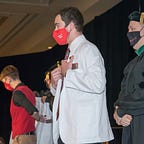The Abbreviated Life of James Garfield
The second president to be assassinated
 Last of the log cabin presidents, James Abram Garfield had potential. The Preacher President was whole-heartedly committed to civil service reform and corruption control following Civil War Reconstruction. Garfield was also a champion of African-American rights and education among his contemporaries.
Last of the log cabin presidents, James Abram Garfield had potential. The Preacher President was whole-heartedly committed to civil service reform and corruption control following Civil War Reconstruction. Garfield was also a champion of African-American rights and education among his contemporaries.
Though his presidency was limited to just 200 days, historians speculate that Garfield had the ability to lead a very successful term in office, potentially even two. Born as one of the poorest men to ever serve in the White House, Garfield’s life was extraordinary in its own way.
A Young Man from Ohio
James Garfield was born on November 19th, 1831 in rural northeastern Ohio, near present-day Moreland Hills. He was the youngest of five children born to Abram Garfield and Eliza Ballou. When he was only two years old, James’ father died, leaving five children to be raised solely by their mother.
At 16, the adolescent Garfield left home and took up work on a canal boat, managing the mules and other animals used for pulling. After only a short time, however, Garfield fell ill and returned home to recuperate. Once healed, the teenage Garfield elected to forego his return to the canal boats and instead enrolled in Geauga Seminary in Geauga County, Ohio.
Following two years at the seminary, Garfield found temporary work as a teacher, putting to use his newly acquired and greatly appreciated skills of oration. He also left Geauga with a new love and future wife, Lucretia Rudolph.
In 1851, Garfield and Lucretia enrolled in Western Reserve Eclectic Institute until 1853, when James transferred out east and finished schooling at Williams College in Williamstown, Massachusetts. He graduated in 1856 as salutatorian. With his prestigious New England degree, Garfield returned home to Ohio and spent time teaching and serving as principal at Western Reserve Eclectic Institute.
Though enjoyable, Garfield did not feel his calling was in the classroom. He instead had acquired a taste for abolitionist sentiment while studying out east. Garfield ran with this and experimented with politics, actively campaigning for Republican John C. Fremont in 1856. He chose to begin a career in law as well, studying under an attorney in Cleveland named Albert Gallatin Riddle. Garfield was admitted to the Ohio bar in 1861.
Garfield’s personal life was also ramping up at this time. He and his adolescent sweetheart, Lucretia, married in 1858 and would go on to have seven children, five of whom would survive infancy (Harry, James, Mollie, Irvin, and Abram). They each went on to lead interesting and prosperous lives of their own.
Civil War Service
When war broke out, Garfield did not immediately join Union ranks. His attention was instead focused on serving out a term in the state’s legislature and working on a speaking tour in northeast Ohio. However, in 1861, Garfield received commission as a colonel in the 42nd Ohio Regiment, though the regiment was not yet formally in existence. As commanding officer, he was tasked with filling enlistments, a job he carried out successfully.
Once thoroughly trained, Colonel Garfield and his troops set off for Kentucky to join the Army of the Ohio commanded by Brigadier General Don Carlos Buell. The general gave Garfield his first orders in late 1861. The colonel and his troops were assigned the duty of freeing eastern Kentucky from the grasp of the Confederates, and in early 1862, they would do just that.
Garfield was promoted to brigadier general following a string of successes out east. He took full control of the 20th Brigade of the Army of the Ohio and moved his soldiers west to merge forces with General Ulysses S. Grant in the pursuit of Mississippi. On the way south, however, Grant’s forces were met prematurely in southwestern Tennessee at the Battle of Shiloh. Garfield’s brigade assisted Grant’s troops in the fighting, which was one of the bloodiest battles of the Civil War.
Following Shiloh, Garfield was once again stricken with an illness. Severely jaundiced, he was forced to return home to Ohio where Lucretia helped him get back on his feet. When well enough, the young Garfield took a position as Chief of Staff under General William Rosecrans in southeastern Tennessee. Garfield and his superior became quite good friends, spending a majority of their time discussing religion and tactics. On the battlefield, Garfield would engage in skirmishes around Chattanooga including the Battle of Chickamauga, until he was elected to the United States House of Representatives in late 1862.
Congressional Career
Garfield won his first seat in the U.S. House of Representatives from the 19th District of Ohio. Shortly after taking his congressional seat in 1863, Garfield budded a friendship with Lincoln’s Treasury Secretary Salmon P. Chase [who is a relative of mine, actually]. Chase and Garfield bonded over their shared passion for abolition and desire to punish the South harshly for secession. They, as well as fellow radical members of the Republican Party, felt that Southerners had forfeited their rights by splitting from the Union, and therefore their lands and property should be confiscated.
Garfield fought hard for abolition in Congress and for African-American voices. Throughout the Reconstruction period, he was vocal in Congress proposing many government and social reforms. Past Reconstruction, Garfield was a fervent supporter of the gold standard, despising propositions for paper money proliferation.
Democrats took over the House of Representatives in 1875 for the first time since the Civil War. Garfield, still serving, was left as the Republican floor leader, and likely would have been the Speaker of the House had his party kept a majority. Despite being in the party minority, Garfield continued his war on political corruption and company monopolies, though he may have had his own corrupt hiccup through involvement in the Credit Mobilier of America Scandal just a few years earlier. This scandal had involved illegitimate financing of the Union Pacific Railroad.
With the 1876 presidential election approaching, Garfield endorsed fellow Ohioan and Governor Rutherford B. Hayes once it became clear that he was the leading candidate for the Republican Party. Once in office, Hayes used Garfield as a strong leading Republican voice in Congress, a common theme of Garfield’s career to this point. In 1879, Hayes even suggested that Garfield make a run at the Ohio Governorship to boost his chances at securing his own shot at a presidential run. Though he rejected the proposal, Garfield did run for the Senate and won election, but never sat for his term.
Short Stint as President
Garfield was a dark horse candidate for the 1880 presidential election, given Hayes’ decision to forego reelection. Despite this, Garfield ultimately came out victorious, beating Democrat and fellow Civil War veteran, General Winfield Scott Hancock of Pennsylvania. The Ohioan secured the presidency with a close popular vote margin of only 10,000, but securely won the electoral vote 214–155.
Right from the start, Garfield once again introduced civil service reforms and erased nepotism from political appointments. In his first act of defiance, President Garfield denied New York Senator Roscoe Conkling’s requests to appoint his political backers and friends to Custom House positions in his state. The President’s disapproval strengthened the Federal Government’s authority and directly fought the patronage he so despised.
Outside U.S. borders, Garfield put in motion a plan to bring all of the republics of the Americas together in Washington in 1882 to discuss trade, but he would never see this meeting through.
Assassination
In Washington D.C. on July 2nd, 1881, President Garfield stood on a platform at the railroad station, speaking to and greeting the American public. Within the crowd of people, a deranged lawyer, Charles Guiteau, approached and shot the president twice.
Though the first shot simply grazed Garfield’s arm, the second lodged deep in his back. Guiteau quickly surrendered himself to police, but not before publicly declaring himself a Republican Stalwart. Guiteau had requested a position in Garfield’s administration multiple times, but true to his anti-nepotistic views, Garfield had ignored Guiteau’s pleas. His refusal was what culminated in the assassination attempt.
Historians and medical scholars agree that with better sanitation and knowledge, Garfield could have survived his injuries. Through all the poking, prodding, bullet searching, and even with the help of a metal detector, Garfield’s wounds became infected. For over 80 agonizing days, Garfield slowly succumbed to his injuries. On September 19th, 1881, the 20th President had died.
The second president to be assassinated began his time in office committed to the ideals of steadfast executive power and corruption control. We will never know how much more progress Garfield could have made if his term was finished, but based on his track record, historians can speculate positively.
The story of James Garfield is truly rags to riches. Unanimously viewed as one of the poorest presidents in American history, the rise of Garfield is impressive. His commitment to anti-corruption and improving civil rights was admirable amongst his contemporaries and still is today.
Without the murderous acts of Guitaeu, the former canal boat manager may have cemented his place in history as one of the great presidents.
Sources
Doenecke, Justus, et al. “James A. Garfield: Life in Brief.” Miller Center, 14 July 2017.
“James A. Garfield.” Encyclopædia Britannica, Encyclopædia Britannica, Inc.
“James Garfield (U.S. President).” Ballotpedia.
“James Garfield.” The White House, The United States Government, 15 Jan. 2021.
“Knowing the Presidents: James Garfield.” Smithsonian Institution.
